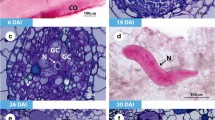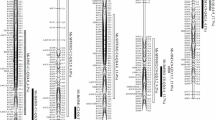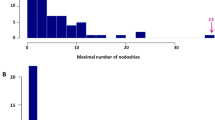Abstract
The Myrobalan plum, Prunus cerasifera, bears a complete-spectrum resistance to the root-knot nematodes (RKN) Meloidogyne spp. in comparison to the main resistance sources in Amygdalus rootstocks that have more restricted spectra, as evidenced by a differential resistance test based on the predominant species M. arenaria, M. incognita and M. javanica and the population M. sp. Floride. Resistance to M. arenaria (A) in Myrobalan plum is controlled by the Ma major resistance genes that are completely dominant and confer a non-host behaviour that totally prevents the multiplication of the nematode. The inheritance of resistance of this self-incompatible species to M. incognita (I), M. javanica (J) and the population M. sp. Floride (F), considered as belonging to a new RKN species, was studied using G1 hybrids from a diallel cross based on five parents, the two resistant P.2175 (Ma1 gene; heterozygous) and P.1079 (Ma2 gene; homozygous) and three host parents, P.2032, P.2646 and P.16.5 (recessive for both genes), completed with the G2 backcrosses P.16.5×(P.2646×P.1079), P.2646 ×(P.16.5×P.1079) and P.2175×(P.2646×P.1079). G1 and G2 clones obtained from softwood cuttings sampled from trees in the field experimental design, rooted in the nursery, and inoculated in containers (six replicates per clone) under greenhouse conditions, were simultaneously evaluated for their host suitability to two to four of the RKN species, based on a 0–5 gall index (GI) rating under a high and durable inoculum pressure of the nematode, and then classified into resistant (R; GI?0.2) or host (H; GI?1.3) classes. The resistance classification of each individual clone, evaluated to two (A/J: 319 clones), three (A/J/I: 249 clones) and four (A/J/I/F: 161 clones) RKN species, from segregating and non-segregating crosses involving either Ma1 or Ma2 or both or none, was identical whatever the species. The independence of the R/H classification from the tested RKN indicates that the Ma1 and Ma2 genes control resistance to all of them, and it is assumed that these genes also control resistance to other minor RKN species. The relationship of the Ma genes with the putative genes involved in Amygdalus sources is discussed with the objective of introducing them into new interspecific rootstocks expressing a complete-spectrum and high-level resistance.
Similar content being viewed by others
Author information
Authors and Affiliations
Additional information
Received: 8 August 1997 / Accepted: 22 August 1997
Rights and permissions
About this article
Cite this article
Lecouls, A., Salesses, G., Minot, J. et al. Spectrum of the Ma genes for resistance to Meloidogyne spp. in Myrobalan plum. Theor Appl Genet 95, 1325–1334 (1997). https://doi.org/10.1007/s001220050700
Issue Date:
DOI: https://doi.org/10.1007/s001220050700




